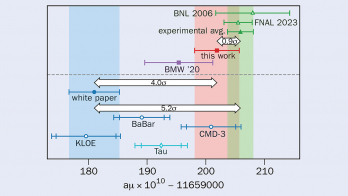edited by G Kane and M Shifman, World Scientific, ISBN 981024522X.
It is notoriously difficult to write with perspective about the history of science of very recent events. This is particularly true in the case of supersymmetry. Actually, supersymmetry is not at all a recent idea; it is about 30 years old and, when compared with the pace of recent progress in science, it seems to come from another geological era.
Nevertheless, the role of supersymmetry in the description of the physical laws and its destiny in the history of scientific ideas are not yet settled.
Physicists are struck by its mathematical beauty, its trustworthy promises to merge general relativity with the principles of quantum mechanics, and its symmetry properties that allow a coherent description of the vastly hierarchical structure of the relevant size scales of the microworld. Nevertheless, we still lack definite experimental evidence for its existence.
This book does not attempt to present a chronological history of the events that led to the theoretical discovery of supersymmetry and its successive developments. Instead it collects personal reminiscences of the pioneers and founders of supersymmetry. In this way it gives the reader all of the elements necessary to reconstruct his/her own favourite history.
Supersymmetry is by now a familiar concept among both theoretical and experimental particle physicists. Entering an auditorium during a conference or a seminar on high-energy physics and listening to a speaker expounding on the production rates of gluinos and squarks, you certainly get the impression that these particles are real entities with well measured properties. In fact they are just a theoretical conjecture, the confirmation or disproof of which is waiting for the Large Hadron Collider to operate at CERN. But how many people in that auditorium know why supersymmetry was first introduced in particle physics, or how superstrings were invented (by Ramond, Neveu and Schwarz) before supersymmetry was even known, or, in a more anectodal vein, how the name developed from the super-gauge symmetry’ of Wess and Zumino to super-symmetry’ (with the hyphen) of Salam and Strathdee? This book is excellent reading for all of those (in that auditorium or not) who do not know the answers or just want to know more.
In the beginning, supersymmetry was a solution in search of a problem. The first proponents did not have in mind the hierarchy puzzle or quantum gravity, which are the main arguments used now to motivate supersymmetry and which did not appear in scientific literature until the early 1980s. Golfand and Likhtman invented supersymmetry when trying to understand parity-violation in weak interactions (before the Standard Model of electroweak interactions emerged). Volkov and Akulov introduced non linear supersymmetric transformations to explain massless neutrinos (interpreted as Goldstone fermions). Then Wess and Zumino rediscovered supersymmetry on the other side of the Iron Curtain and, with formidable theoretical developments, opened the gate to the superworld.
There is a lot to be learned from the early developments of supersymmetry and this book provides the necessary material in an unusual form – through personal recollections. It has to be said that many of the contributions contain technical discussions of the theoretical progress that require a good scientific knowledge on the part of the reader. However, these are mixed with reminiscences, personal remarks and anecdotes that make the reading more suggestive and captivating.
The book also contains an essay by R Di Stefano that attempts a systematic study of the historical developments of supersymmetry. I found this essay, written in 1988, too dated to have sufficient vision of the field. On the other hand, most contributions from the original founders of supersymmetry are full of interesting remarks, both from scientific and historical points of view. Particularly vivid is the chapter written by Yuri Golfand’s wife, with an intense and passionate portrait of her husband and of the sufferings, injustices and intellectual humiliations borne by the Jews in the Soviet Union.






